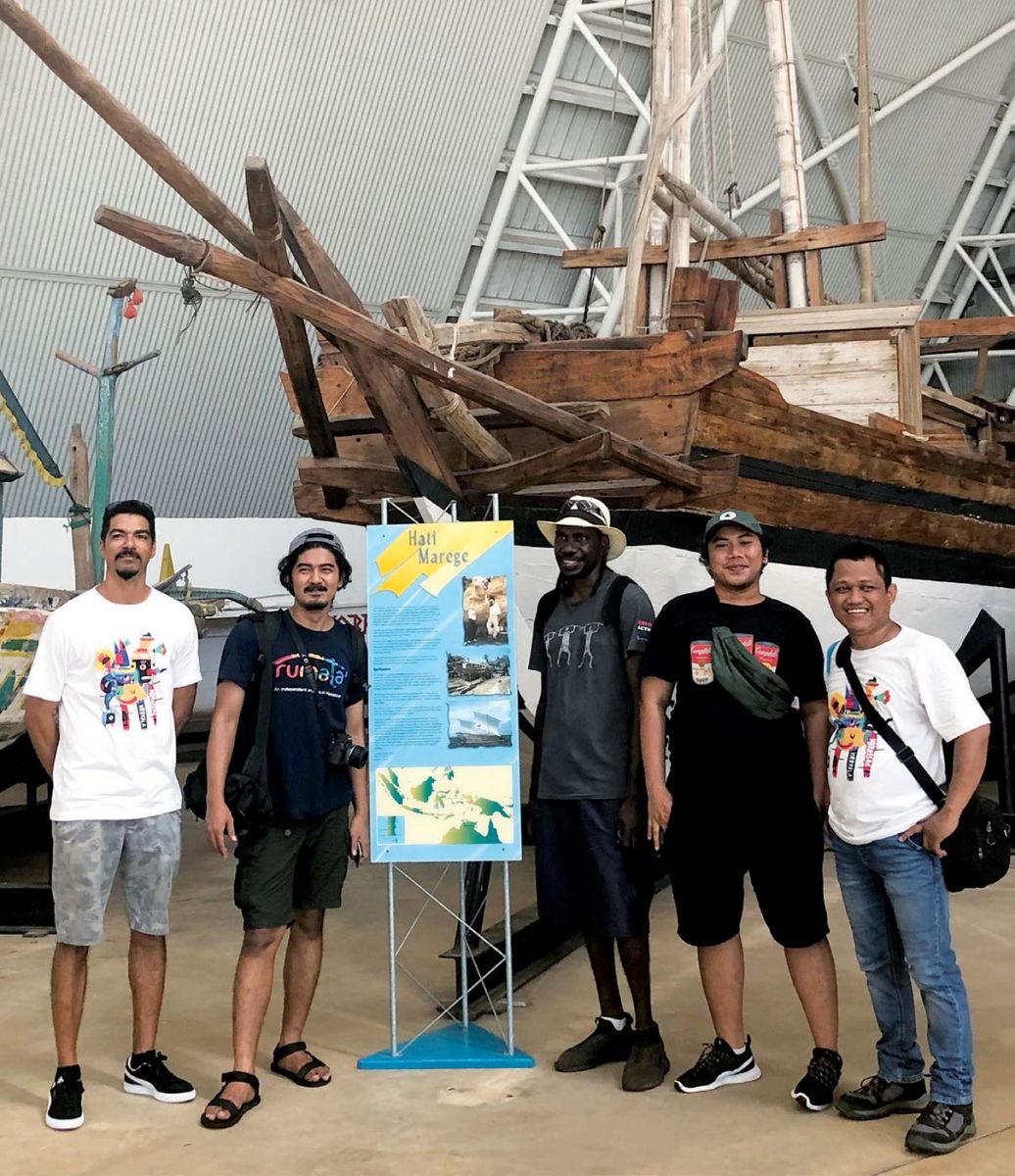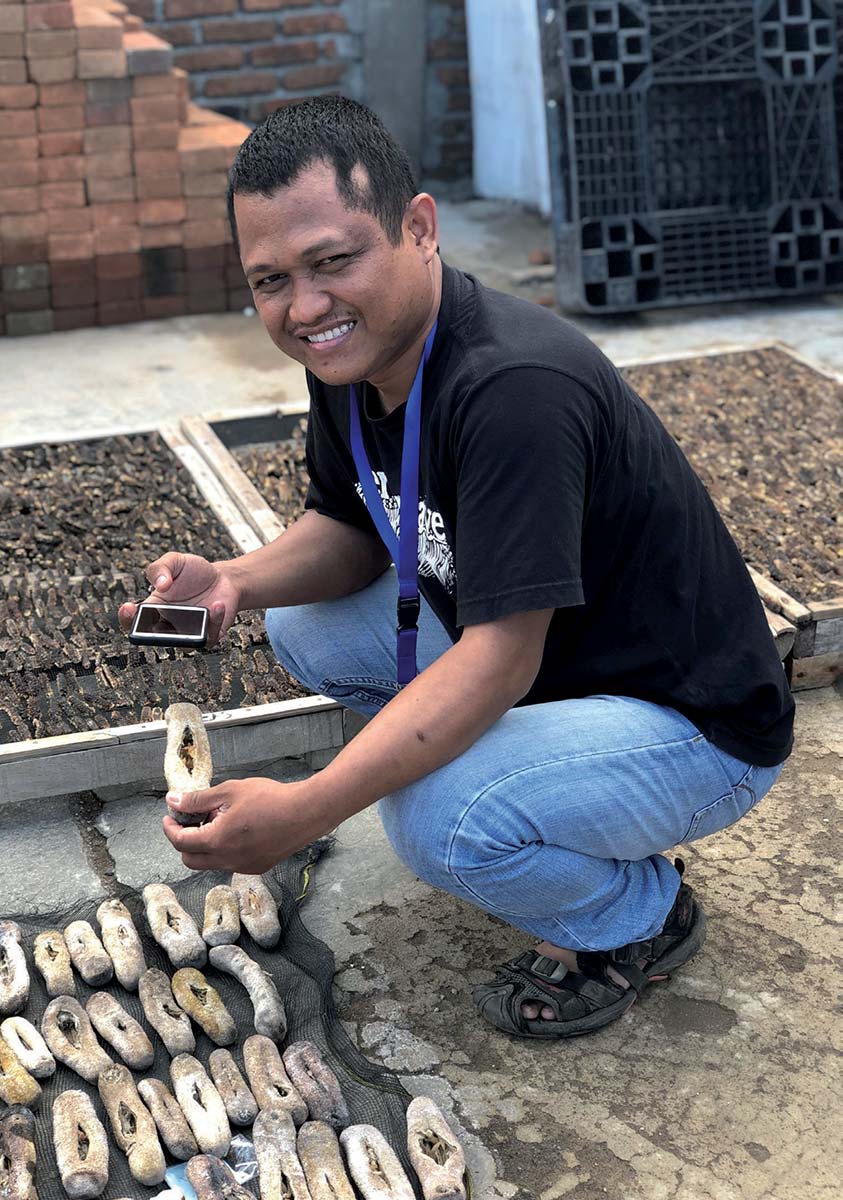Makassar and Northern Australia. An artistic perspective of the shared history
In December 2018, three Yolŋu artists from Yirrkala, Northern Australia and three artists from Makassar, Indonesia participated in an artist exchange program organised by the Wilin Centre, Victorian College of the Arts, The University of Melbourne. The centre worked together with Rumata’ Art space in Makassar and Buku-Larrŋgay Art Centre in Yirrkala to invite Adi Gunawan (visual artist), Nurabdiansyah Ramli (visual designer and researcher) and Muhammad Rais (filmmaker) from Makassar, and Arian Pearson (musician and sound producer), Barayuwa Mununggurr and Dion Marimunuk Gurruwiwi (radio DJ) from Yirrkala.
The creative practice research project funded by the Australia-Indonesia Centre aims to facilitate cultural exchange between the young artists, based on the historical relationship between Makassan seafarers and the First Nations peoples of the north coast of the Australian continent between the mid-18th century and early 20th century.[1]
After the artists spent time in both Makassar and East Arnhem Land, they returned to their respective countries where they were given time to reflect on their experience through the creation of artworks. This essay follows the creative process and personal experiences of the three Makassan artists who joined the historical research-based arts project. It demonstrates how the project functions as an effective medium to spread knowledge on shared history between the two neighbouring countries, both on personal and artistic levels, and that the learning of the history of pre-European contact in Australia has changed the Makassan artists’ perspectives on Australia.
New learning, old history
Mural artist Adi Gunawan, one of the three young Makassan artists selected for the program, commented: “I have learned about the street art in Australian cities and that was the only reason for me and my wife who is also an artist to plan a visit to Australia. I never thought that it was the historical relationship between Makassan and Northern Australia that would bring me to Australia and then to create an artwork after the visit.”
Nurabdiansyah Ramli, one of the other Makassan artists, learned about his family members who had sailed to Australia to fish the waters off the coast. “I feel the connection, however, I have never had opportunities to further explore the history as the information I have received from Australia is mainly about higher education and contemporary arts.”
The three artists from Yirrkala had previously learned about the presence and influence of Makassan seafarers through paintings, drawings, objects and Yolŋu traditions and oral stories, and so their visit to Makassar (2-5 December 2018) was an opportunity “to confirm” the cultural knowledge they had about Makassar. As one of the artists, Arian Pearson, described: “Our parents, grandparents and great grandparents shared the stories, including those about the marriages between our people and the Makassans. They often reminded us that we have cousins and relatives in Makassar. This is my first time visiting Makassar and seeing the trepangs [sea cucumber] in a village outside Makassar; then I learned about the traditional boats and listened to the locals speak in the Makassan language. For the first time, the history felt so real.”
In a focus group discussion after the visit, questions about who Australians are (are they white, Indigenous, migrants?) and about the history of Aboriginal people and Indigenous arts, dominated our discussion as the visiting artists were overwhelmed with the rich tradition, art and history of Yolŋu, its connection with Makassan trepangers and Chinese traders, as well as issues and challenges faced by Indigenous people in Australia today.
“Our understanding of Australia before the visit was focused on Australia as a white country as well as a land of hope for migrants; a country with world class education – because many of our friends have studied, are studying or are planning to study in Australia. However, through this research-based art project, we have entered the pre-European period, and our ancestors played a very significant role during this period. We did not learn this at school. Our Yolŋu friends in Yirrkala and Bawaka were enthusiastic to share their stories about Makassan influences in their ceremonies, songs, dances and art works. Meanwhile, as the Makassans, we came to Northern Australia with almost zero knowledge about the relationship”, commented Muhammad Rais.
Creation of artworks
The three artists worked on a collaborative art project exploring key elements they learned during the visit: trepang, boats and ships, friendships between Makassan seafarers and Yolŋu people, traditional ceremonies, and the sea that connects the two cultures. Adi Gunawan decided to produce a relief about the Yolŋu tradition to bid the Makassan seafarers farewell, with both groups sitting on the beach watching the sunset together. Normally Makassans would stay in Arnhem Land for six months, to catch and process the trepangs until ready to be sold to Chinese traders. Each time the season ended, they would bid a farewell and attend the sunset ceremony. Muhammad Rais also explored the traditional ceremony in his video mapping project, working with smoke, lights and colours.
Nurabdiansyah created a replica of a Makassan traditional boat [Paddewakkang] for his artwork. “My visit to Arnhem Land was a mind-blowing one. It was the first time I traced down my ancestors’ footprints, seeing the tamarind trees that they planted hundreds of years ago, listening to oral histories and tales told by our Yolŋu brothers and sisters, finding the remnants of clay pots brought by Makassans to Australia. The history is very old, however, through this project, we are learning new things about knowledge and technology transfers between Makassans and Yolŋu people. I am lost in my own history.”
In an international symposium to open the artist exchange in Makassar, the initiator of this program, Prof. Richard Frankland from the Wilin Centre, explained that the project mainly focuses on how young generations in Makassar and Arnhem Land respond to the shared history through the arts, since in both countries, many students and people in general are not aware about our shared history.
The three artists list “contact and friendship with Australian Indigenous people” as the most valuable thing gained from the program. “Australia is the top destination for education. Many young Indonesians study in major Australian cities, but this project has led us in a very different direction because our first encounter with Australians was with the Yolŋu people, the owners of this part of the continent, and not Australians that we have seen at popular tourist destinations in Bali or on the popular media. That is the beauty of this project. The arts serve as an effective way to learn about our shared-history”, concluded Nurabdiansyah Ramli.
Lily Yulianti Farid, co-founder and co-director of Rumata’ Artspace Makassar, a published author and art event producer. Her published books include Family Room (Lontar Publisher) and the Indonesian translation of Anita Roddick’s autobiography Business as Unusual (Gramedia Pustaka Utama).
[1] The Makassans caught and processed trepang [sea cucumbers] from (at least) 1780, off the north coast of Australia, and sold the commodity to Chinese traders. See Macknight, C.C. 1976. The Voyage to Marege’: Makassar Trepangers in Northern Australia. Melbourne: Melbourne University Press.

